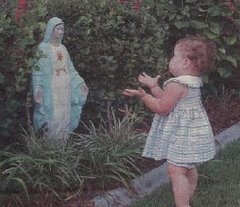Here's a story I made up and told to some of my grandchildren about three weeks ago.....
{bunny drawing by Donald Brown}
Under a large oak tree lived a family of bunnies—Daddy Bunny, Mommy Bunny, and five little bunnies. Daddy had made  sure that his family was safe by building their home under the tangled roots of the tree. Mommy Bunny had made it a very nice home, and the little bunnies lived there happily.
sure that his family was safe by building their home under the tangled roots of the tree. Mommy Bunny had made it a very nice home, and the little bunnies lived there happily.
When the bunnies were hungry, Daddy Bunny stood outside the hole and watched for the fox while the little bunnies ate grass and other good things. If the fox came near, Daddy Bunny would quickly call for the little bunnies to run and go down the hole into their house.
Foxey, the fox, also had a home under a large rock on the next hill. He lived in the den with his Mother who was getting old, so Foxey had to find food and bring it home for her to eat. Recently Foxey had been able to bring home some fresh young chickens from Farmer Brown’s yard, but now Farmer Brown was carrying a shotgun during the day and Foxey was scared to get too close to Farmer Brown’s house and yard.
Foxey and his mother were getting very hungry, but the only food Foxey had been able to find were black beetles under a rotten log. He started grumbling about how his stomach hurt and his Mother said, “Foxey, why don’t you try to catch some bunnies? I know there are bunnies on the edge of the forest near the big oak tree and they would taste really good.”
Foxey sadly replied, “I’ve tried to catch them, but they run too fast and escape into their hole. I can’t dig them out because the tree roots get in the way.”
“You’ve got to be a smart fox and use your head, Foxey,” said Mother Fox. “Trick them into going further from their hole and you’ll bring us home a nice bunny dinner.”
So that evening, Foxey decided to go back to Farmer Brown’s place. He knew Farmer Brown’s chickens were locked in the chicken house for the night and Farmer Brown had gone to bed without his shotgun by his side. This time, Foxey did not want chickens, he wanted something else.
Farmer Brown had built a fence around his new garden that protected his new carrots and lettuce from bunnies who love vegetables. But Foxey was bigger and stronger than the bunnies and easily jumped over the garden fence. He began to gather dozens of new young carrots.
Then he went under the moonlight to the big oak tree where the bunnies were sleeping deep in the hole in the ground. Foxey put a few carrots around the hole—just enough to tantalize the young bunnies. He saved the nicest looking carrots to make a path of carrots away from the hole and down a path to some bushes.
The next morning, Foxey hid himself under a large green bush and close to the trail of carrots. Sure enough, the little bunnies came out of the hole and their Daddy watched them play and eat grass for breakfast. It took less than a minute before the little carrots were discovered. “Daddy, Daddy, it rained carrots last night!” said one of the little bunnies.”
“Oh, they taste so good!” said the oldest bunny. Even though his mouth was almost packed with carrots, he was eager to find more. Seeing the bright orange carrot trail leading down the path, the young bunny started picking up the wonderful food as he got further and further from his hole.
Then he heard his Daddy yell, “Run! Run! The fox! Hurry!”
All the little bunnies were good bunnies who knew they had to obey Daddy immediately, and they hopped quickly toward the hole, with Foxey right behind the young bunny who had followed the carrot trail. Foxey’s mouth was wide open to grab the bunny, but he hopped down the hole and disappeared right before Foxey’s mouth closed. That night the Bunny family was very thankful that all their children were alive. And the littlest bunny who was sometimes disobedient, now knew how important it was to obey his Daddy.
Foxey was tired and discouraged. He knew Mother Fox would be very unhappy that there was no food today. As he walked back to his den, he saw a piece of colored paper that had been blown by the wind and was now caught in the deep grass. Foxey read the advertisement, “Circus Comes to Town -- Clowns, Trapeze Artists, Elephants, Trick Horses, …” The piece of paper said the circus started tomorrow.
Foxey knew he would not be able to go to the circus. First of all, foxes were not welcome at the circus. Second, he didn’t have any money. But Foxey had what he thought was a smart idea. He took a few hairs off his long bushy tail and with some black oil found under an old car, he carefully printed new words at the top of the paper. Now the top of the advertisement said, “FREE TICKETS FOR BUNNIES.”
Later that night, Foxey took the circus advertisement and tacked it to a tree near the Bunny hole. Then he went home and told his Mother about his plans. Actually, Foxey had two plans. He would first try to catch the bunnies as they left their home to go to the circus, but if that plan failed, he would go to the circus and grab the bunnies there.
When Foxey told his mother his plans, she replied, “I’d better make you a special costume for you to use if you go to the circus. How would you like to be a clown?” So Foxey’s mother sewed all night long to make a clown outfit for Foxey to wear at the circus. It was a beautiful costume with pink and red and orange stripes. There was even a place in the back to hide Foxey’s long bushy tail and a giant green and yellow hat. Foxey decided to take some paint with him to paint his face, and some tape to hold his ears down. Then he went to the Bunny hole to wait until the sun came up.
Sure enough, the next morning, the bunnies came out of their hole and saw the sign. “Daddy, Daddy, Look! We can go to the circus for free! And the circus is today. Please take us, Daddy,” pleaded the little bunnies.
Daddy Bunny thought a little bit and decided that the circus was a really good idea because it would be fun for his children and besides, it didn’t cost any money for bunnies. He lined up all his children near the hole and told them, “Listen to your Mommy and me because we have to be careful not to be caught by the fox. We are going by a secret way to the circus.”
“Which way?” said the oldest bunny who had almost been caught and eaten by the fox while picking up carrots.
“Down by the railroad tracks, there is a tunnel into town and the fox can’t catch us there. The tunnel ends where the circus tents are located,” said Daddy Bunny. “Get ready, kids. We’re going to the circus today!” And all the bunnies jumped down their hole to get ready.
Mommy Bunny dressed all her little bunnies in nice clean clothes. Within a few minutes the bunnies hopped out of their secret second hole (which the fox did not know about). Down they hopped to the railroad tracks and the tunnel to go to the circus.
After the bunnies had seen the advertisement posted on the tree and gone down into their home to change clothes, Foxey continued to watch the hole to the Bunny home. He thought, “Now I’ll catch a bunny or two when they leave their home to go to the circus.” Foxey waited and waited and waited, but no bunnies came out again. Finally, Foxey began to look carefully on the back side of the old oak tree. When he saw the secret second hole to the Bunny home, he knew he had been fooled. Foxey took off running as fast as he could toward town and the circus tents because he knew that’s where the bunnies were going.
The little bunnies had a good time hopping through the tunnel by the railroad tracks. They quickly learned not to jump too high because their heads would hit the top of the tunnel. “Ouch,” said the oldest bunny who was also the tallest. Soon all the bunnies arrived at the end of the tunnel and saw the circus tents.
“Look, Daddy! See, Mommy! The elephants are going into the biggest tent. We’re going to be late!” The Bunny family quickly hopped to follow the elephants into the big tent. They found a place to sit below the front row seats and began to watch the circus.
Foxey ran very, very fast to reach the circus. He saw clowns come out of a small tent and walk over to the biggest tent where there was a lot of noise and cheering. “That must be where the circus is,” thought Foxey. “I’d better get dressed in my clown outfit before I go to the circus in the big tent.”
Foxey quickly put on the beautiful clown costume Mother Fox had made, hid his tail, painted his face, and taped his ears down. Foxey looked at a mirror and saw he looked like a real clown. “I’ve always wanted to be a clown,” thought Foxey. “But I’m so hungry, I’m going to get a bunny to eat first!”
Little children at the circus began to look at the new clown that had just entered the big tent. Foxey decided to dance on his hind legs. The children laughed, and Foxey picked up a ball and started to juggle and sing. Pretty soon, he found an old shoe and a rotten apple, and began to do all kinds of tricks to make the children laugh. The children applauded and laughed as Foxey used all of his imagination to be a funny clown.
But Foxey was hungry for those bunnies. He saw them sitting under the first row seats on the other side of the tent, so he began to do more tricks as he danced his way nearer and nearer the bunnies. All the children were laughing and clapping at Foxey as he twirled and juggled, getting closer and closer to the bunnies.
From high on the trapeze, two acrobats were swinging back and forth. One of them said to the other, “I don’t remember that clown, do you?”
“No,” said the second acrobat, “but he’s really good at making the kids laugh.”
Just then Foxey twirled in the air and caught the rotten apple in the old shoe. He put the old shoe on his foot and everybody laughed more as the apple got squashed. But all the twirling and dancing had caused Foxey’s costume to come apart in the back.
“Look,” said one of the acrobats. “That’s not a clown! That’s a fox! See his long bushy tail! And he’s moving closer to those bunnies. He’s going to eat them!”
“Let’s go!” said the other acrobat on the trapeze at the top of the tent. The two acrobats grabbed a trapeze bar and swung down from their trapeze. One of them grabbed Foxey by his legs and swung him up in the air.
Foxey screamed, and the children laughed more and more. The two trapeze acrobats began to toss Foxey back and forth between them and Foxey was as scared as he ever was in his whole life. Everyone in the circus tent thought this was a wonderful show. Finally, Foxey was tossed way up and turned several sommersaults in the air before he landed on the net. He was so dizzy, he could not think or run.
The audience clapped and clapped for Foxey the clown and the trapeze star. Even the little bunnies applauded, although Daddy Bunny said, “I’d think it’s time to go home.”
“Take a bow,” said the two trapeze acrobats who landed on the net next to Foxey. He bowed shakily and then they helped him out of the net where Foxey took another big bow and reeeived a lot more applause, especially from the children.
“You’re a very good clown,” said the Ringmaster who had walked over to meet Foxey. “I especially like your costume. Would you like a job working for my circus?” he asked Foxey.
Foxey saw the bunnies hopping out of the tent and realized his bunny dinner was gone again.
“Let’s talk about your salary over dinner,” said the Ringmaster. “I’m sure we can pay you enough to make you interested in becoming a clown with our circus.”
“Dinner! Yes, I’d love to talk with you at dinner,” said Foxey hungrily.
Foxey had a wonderful dinner with all kinds of great food, but he started thinking about his mother. “Mother Fox made my costume,” answered Foxey to the Ringmaster’s question.
“Well, we need a good seamstress to make and repair the costumes that are needed by people in our circus,” said the Ringmaster. “Do you think your mother would like to have a job sewing circus clothes?”
“Do you mind if I take the dinner leftovers home and ask her?” said Foxey.
“Go ahead, take all the extra food left on the table,” said the Ringmaster. “Just come back tomorrow and tell me if you and your mother want to work for the circus.”
When Foxey came home to his den, Mother Fox was waiting hungrily. She listened to Foxey’s story and saw all the good food he had brought. When she had eaten all of it, she realized that cooked dinners were far better than eating raw chickens and rabbits and (ugh!) beetles from under rotten logs.
The next morning, Foxey and his mother left their den for the last time to live with the circus. That is where you can find them today, in their own fancy tent. Foxey is now a great clown who loves to entertain children, and Mother Fox sews all the costumes for the circus. They eat better than they ever have in their whole lives.
By the way, the little bunnies play safely every day near their big oak tree without being scared of being eaten by Foxey. They now have a wonderful life.






















